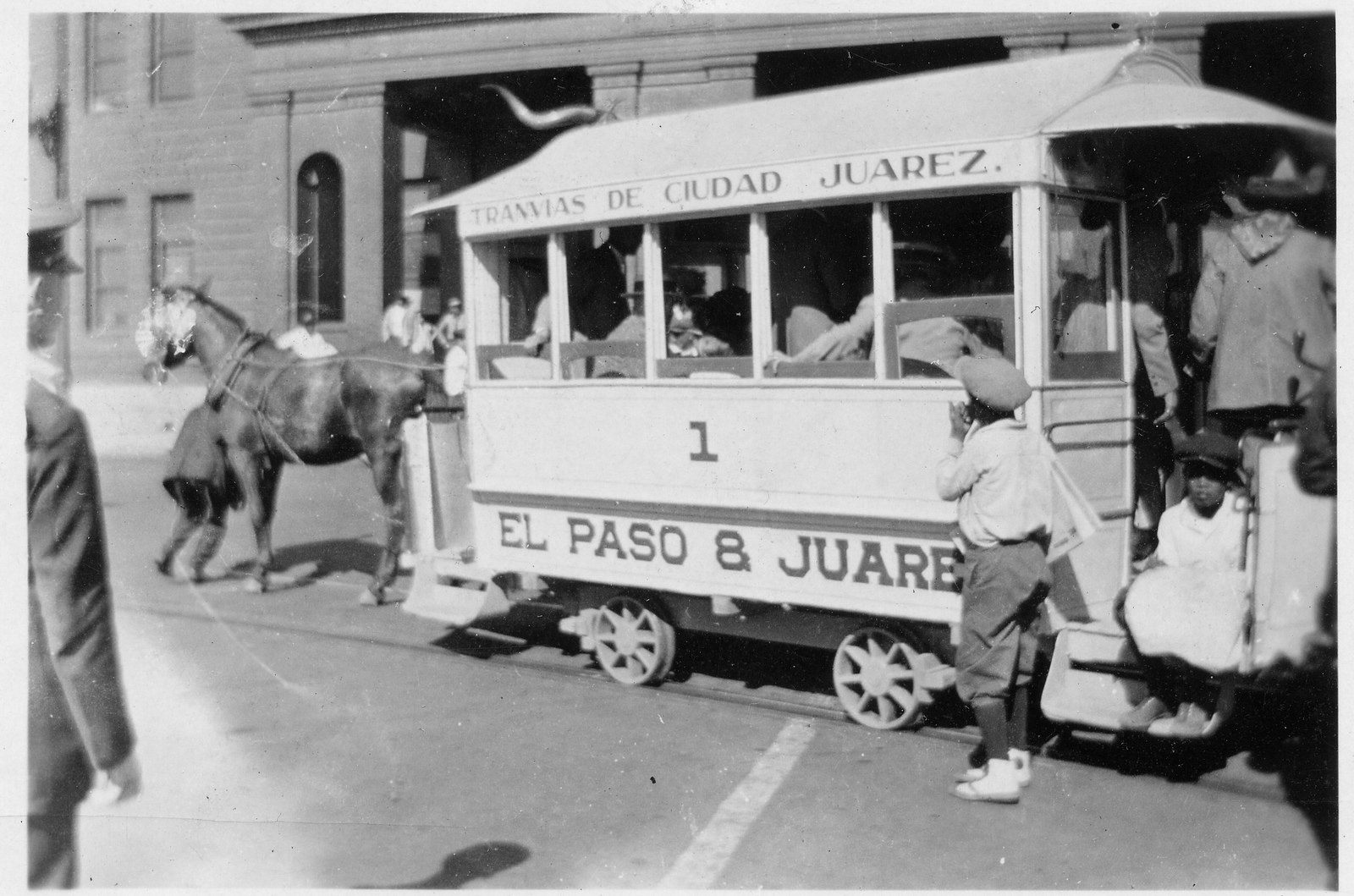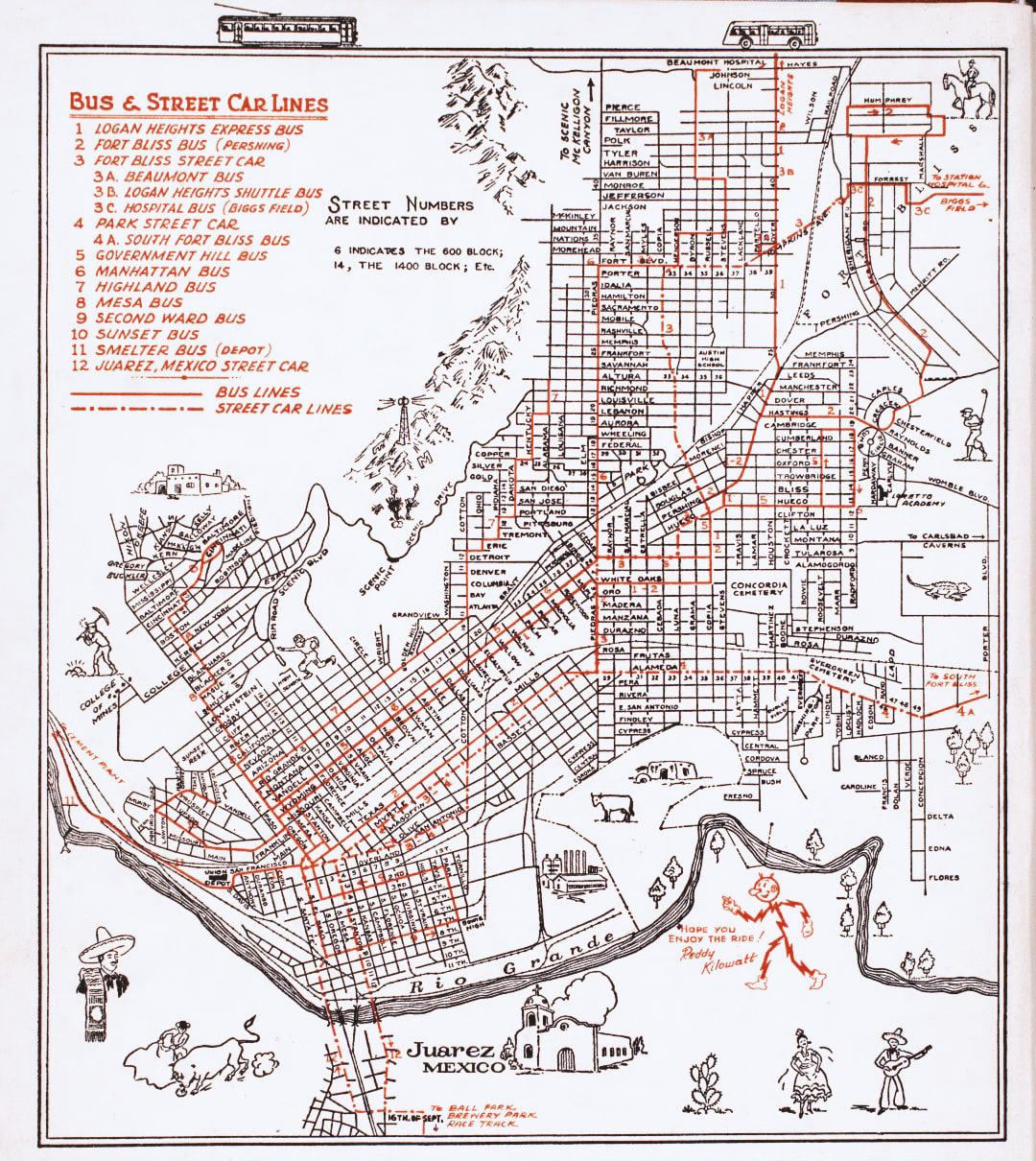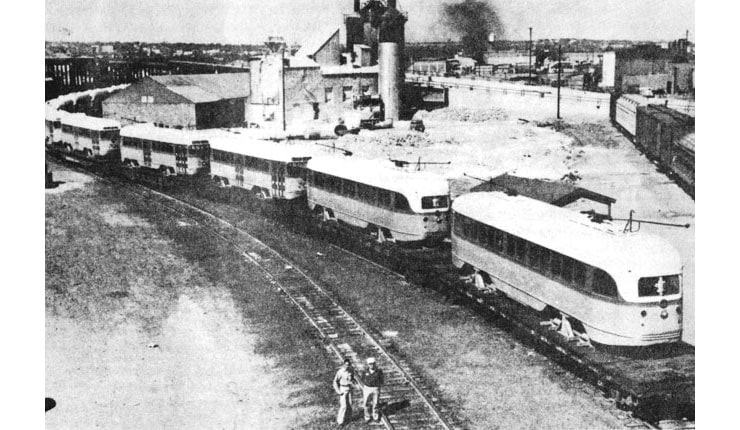-----
 |
| A mule-led El Paso & Juárez horsecar waits for passengers, circa 1880s. (Public Domain) |
 |
| Another mule-drawn streetcar in the 1880s, displaying the Spanish name. Note the man ducking out of the way of the horse. (Public Domain) |
One stand-out animal on the El Paso Railway was Mandy the Mule, who the city respected as a force and transit schedule all to herself. On one hot afternoon, a travelling salesman saw that Mandy had decided to take a rest despite already pulling a horsecar through the city. After appealing to her driver to get her going, her driver replied:
The El Paso City Lines merged in 1977 with two other bus companies to form the Sun City Area Transit (SCAT, oh no...), which would eventually be renamed to Sun Metro in 1987. Immediately after the streetcars were sent for scrap, though, many plans were drawn up to bring back the streetcars as soon as possible. After all, it was the middle of the American Bicentennial and cities like Tucson, Seattle, and Fort Collins were using this newfound patriotism to bring back some of their old city identity through street railways. It took many proposals for El Paso to get back their own streetcar, but eventually one idea stuck and gave this street railway the resurrection it needed.
"Hit Mandy?! [...] why if I was to lay a hand on that mule the town wouldn't stand for it."
While Mandy would charm the town and encourage travel over its mule-driven system, modernisation was already being planned by the end of the 1880s. The International Light and Power Company was issued a charter to operate in El Paso in 1889, and so began the gradual electrification of the city and its streetcar lines. Mandy herself would retire from the horsecar business in 1901, and the four former mule railways would now merge into one big company that same year: The El Paso Electric Railway Company, or EPER.
 |
| A postcard rendering of the International Bridge bound for Mexico, 1920. The trolley is standard American Car Co. (Public Domain) |
In preparation to send the first streetcar to Ciudad Juárez in 1902, horsecar operators were re-trained and re-licensed to drive electric streetcars. The first arrival occurred on January 11th and from there, the city lines expanded by filling industrial areas and residential suburbs alike with convenient streetcar service. Two carmakers were contracted to supply new rolling stock in 1902, American Car Company and pioneering coachbuilder John Stephenson (who built the first streetcars for the New York and Harlem). The fleet started with 24 cars, but soon grew to 28 cars in 1903, then confusingly, American Car and Brill would deliver 12 more cars numbered 71-83.
 |
| One of the "Turtleback" Stone & Webster cars in El Paso, 1949. Note the National City Lines livery. (Don Ross) |
By 1912, Stone & Webster (a Boston engineering firm who also operated streetcars in Dallas, Houston, and Seattle) took over operations of the EPER and introduced their own proprietary streetcars dubbed the "Turtlebacks". They were emblematic of the "big horsecar with separately-fitted front ends" that characterised early American Car Co. products like the Portland Council Crests, but their large top "hump" instead got them nicknamed "Turtlebacks." They would arrive in time for the new interurban line to Ysleta (13 miles downriver from the city center) to open in 1913.
 |
| An early-1930s map of the El Paso Electric Railway, showing the small loop into Ciudad Juárez and the incoming bus services on the top right. (CRRMA) |
The 1920s would end up being the best years for the El Paso Electric Railway. Fed on tourist dollars eager to engage in the "exoticness" of Mexican culture (and also to escape prohibition across the Mexican border), the system now spanned 64 miles between El Paso's dense suburban network and its direct line into Ciudad Juárez. Suburbs like Sunset Heights, Kern Place, Segundo Barrio, and Morningside Heights all became highly developed, while 19 million passengers would enjoy riding on the system's 103 streetcars. This peak period ended in 1925, when the Ysleta line was superseded by bus usage. The El Paso Electric Railway Company would rename itself to the El Paso Electric Company that same year, with the trolleys retained under its "Transportation Division."
Further closures would occur into the 1930s until by 1940, the only remaining routes on the EPER were the Fort Bliss, Highland Park, and Juárez lines. Many of the EPER's former trolley cars were sent to scrap drives as El Paso Electric Company divested control of its Transportation Division to American City Lines, a holding company under the National City Lines (NCL) conglomerate. NCL would rename the Transportation Division to "El Paso City Lines" and kept only one line in service: The El Paso/Juárez Line.
 |
| A long train of 17 P1-type PCCs arrives in El Paso from San Diego, 1950. (CRRMA) |
After the war ended, NCL retired the rest of their aging streetcar fleet and transferred 20 P1-type PCC (Presidents' Council Committee) cars from the San Diego Electric Railway (Also NCL) to El Paso by 1950, all clad in their white-green-yellow "Salad Bowl" scheme and numbered 1501-1519. El Paso City Lines would also be the last electric railway to convert to PCCs. The cross-border loop line operations would continue in a somewhat token fashion until 1967, when service was interrupted to allow for international bridge rebuilding.
 |
| A rare sight for 1970: a classic P1-type PCC car (with the split- destination boards) is stuffed full of American tourists bound for Mexico at the Palace Theater. (Public Domain. |
The 1938-built PCCs were now over thirty years old by the turn of the 1970s, and were unfortunately becoming disliked by Mexican shop owners in Ciudad Juárez due to the lopsided businesses of well-to-do citizens hopping the border to shop American wares. This came to a head in 1973, when Mexican toll-workers blocked PCC No. 1518 from leaving Juárez to save local businesses. 1518 would continue to be held until 1974, when mounting economical pressure forced El Paso City Lines to end cross-border streetcar service. Local service in El Paso was attempted, but only for a short while until the entire system was finally brought to an end due to aging equipment and border crossing difficulties. The PCC fleet was left to rust in the desert until some time before 1993, when a gas company moved them into their yard. Six eventually found their way into preservation.
 |
| The leaving-Juarez bridge in the mid 1950s, with an unidentified PCC sharing the road with Chevrolets. (Bliss Productions, El Paso City Lines Inc.) |
 |
| El Paso City Lines 1514 (Ex-SDERy 523) and sisters at a gas company yard in San Jose, July 1993. Note the front-mounted trolley poles added later on the single-ended cars to avoid backpoling. (Drew Jackisch) |
-----
Thank you for reading today's Trolley Thursday post! This is inevitably going to be a Part 1 of 2 just because of how long it is, but we hope you enjoy reading it nonetheless! A lot of this information comes direct from the current El Paso Streetcar's operators, the Camino Real Regional Mobility Authority, whom you can follow on Twitter and Facebook if you would like to support them, as well as Adrian Gamble's "Once Upon a Tram" series on Skyrise Cities (which Twice-Weekly Trolley History I guess takes inspiration from). Don't forget to look up the El Paso City Lines Inc. Historical Group on Facebook as well! Until next Tuesday, you can follow myself or my editor on twitter if you wanna support us, and maybe buy a shirt as well! Ride safe!

I find it fascinating how a city's transportation system can evolve from mule power to electricity.
ReplyDelete